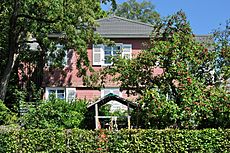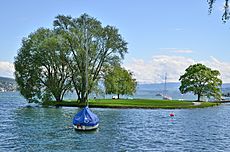Schweizerische Ausstellung für Frauenarbeit facts for kids
The Schweizerische Ausstellung für Frauenarbeit (SAFFA), which means "Swiss Exhibition for Women's Work," was a special event held in Switzerland. It took place twice: first in Bern in 1928, and then in Zürich in 1958. SAFFA was organized by several Swiss women's groups, including the Federation of Swiss Women's Associations (BFS) and the Swiss Catholic Women's League (SKF). The main goal was to show how important women's work was, especially after wars, and to fight for women's rights.
Contents
SAFFA 1928: A Big Step for Women

Before the first big SAFFA, a smaller exhibition about women's work was organized by Rosa Neuenschwander in Bern in 1923. This set the stage for the larger event.
The first SAFFA took place in Bern from August 26 to September 30, 1928. It was held in an area known as "Viererfeld." The main organizer and chief architect was Louise (Lux) Guyer. She was the first Swiss woman to become an architect. Lux Guyer built the exhibition halls very quickly, in just three months. She used special wooden parts that were made beforehand.
This exhibition showed the many ways women contributed to families, jobs, science, and art. It highlighted how important women's work was for the Swiss economy and society. SAFFA 1928 also helped women feel more confident. It pushed for women to have political rights, like the right to vote. It also argued for women to have the right to work and be recognized as full citizens. At that time, women in Switzerland did not have the right to vote in all areas.
SAFFA 1958: Building on Success

The second SAFFA was held in Zürich from July 17 to September 15, 1958. It was led by the Federation of Swiss Women's Associations (BSF) and involved over 100 women's groups. The exhibition was built on the Landiwiese in Zürich-Wollishofen.
Before the exhibition, an artificial island called the Saffa-Insel was created. This island is still a popular place today. People use it for swimming in the summer and for different events.
Annemarie Hubacher-Constam was the chief architect for the 1958 exhibition. The theme was "Life circle of women in family, occupation, and country." SAFFA 1958 showed women different opportunities in education, work, shopping, and free time. The economy was growing, and women were needed as both workers and shoppers.
The exhibition promoted a "three-phase model" for women's lives. This idea suggested that women would work before marriage, then focus on motherhood, and later return to the workforce. Women were also encouraged to bring harmony to their families and communities. The exhibition wanted men to understand how much women contributed to society. It aimed to motivate men to help fix unfair treatment against women.
The 1958 exhibition was a huge success, attracting 1.9 million visitors. It was planned and designed entirely by women, including architects like Berta Rahm and Claire Rufer-Eckmann. A new and exciting feature was the "rotundas," which were round buildings showing women's unity. Sections like "my home – my world" and "in the realm of the kitchen" were popular with housewives.
The 1958 SAFFA happened just before a vote on women's right to vote. The organizers were careful not to be too aggressive in their demands. They even created a "men's paradise" section! During the Saffatheater, actor Jörg Schneider performed in a comedy called Lysistrata.
Women at the exhibition showed many new ideas. For example, the opening concert featured the Saffa Women's Orchestra. It was made up only of women musicians and led by Hedi Salquin. She was the first woman conductor to graduate in Switzerland.
The exhibition made a lot of money. These profits were used to help women's support groups. The Saffa island was dedicated to women and is still owned by the canton of Zürich.
SAFFA 2020: Looking to the Future
In 2007, the Swiss government signed an agreement to fully recognize women's human rights in Switzerland. Because of this, the frauennet.ch website suggested organizing a third SAFFA. They proposed this idea during their women's picnics on the Saffa-Island in Zürich.
However, the project could not start right away due to money issues. Now, Alliance F, which used to be known as the Federation of Swiss Women's Associations (BFS), is preparing for a third SAFFA. They created an association called "2020" for this purpose. They also started a project called "2020 – der weibliche blick auf die zukunft," which means "2020 – the female look at the future."
This project aims to gather ideas and visions for the future of society from women's perspectives. It wants to share these ideas with the public in a suitable way. A first online presentation happened in 2013, starting the work towards SAFFA 2020.
The project "2020 – der weibliche blick auf die zukunft" has the support of important political figures. These include federal councillors Doris Leuthard, Simonetta Sommaruga, and Eveline Widmer-Schlumpf. Former councillor Micheline Calmy-Rey also supports the project.
See also
 In Spanish: SAFFA para niños
In Spanish: SAFFA para niños
- Bund Schweizerischer Frauenvereine (BFS)
- Women's suffrage in Switzerland
Images for kids



